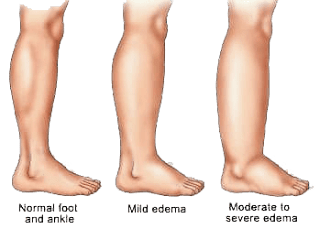The swelling may be generalized or limited to a limb or part of a limb. The swelling often occurs in the feet and in the legs. However, bedridden patients sometimes develop swelling in the buttocks, genitals, and the back of the thighs.
Women who lie on only one side of the body may develop swelling of the breasts on that side. In rare cases, the hand or arm swells. Sometimes limb edema suddenly develops.
Most often, dropsy develops slowly, starting with weight gain, eye swelling upon waking in the morning, and a feeling of tight shoes at the end of the day. Sometimes patients experience a feeling of constriction or fullness. Depending on the cause of the swelling, other symptoms may be present, such as shortness of breath or pain in the affected limb.
POSSIBLE CAUSES AND SYMPTOMS
Angioedema (Quincke's edema)
Signs: Painless edema, most often in the face, lips, and sometimes tongue. Sometimes itching or tightness. Swelling that leaves no depression on pressure (hard swelling).
Blood clot in deep veins (deep vein thrombosis)
Signs: Sudden swelling. Usually pain, redness, fever, and/or tenderness in the affected area. If a clot moves and blocks an artery in the lungs (pulmonary embolism), it usually causes shortness of breath and sometimes hemoptysis. Sometimes in people with risk factors for blood clots (recent surgery, trauma, bed rest, leg cast, hormone therapy, cancer, or a long flight).
Chronic venous insufficiency (causing blood to accumulate in the legs)
Signs: Swelling of one or both ankles or legs. Chronic moderate discomfort, aching pain, or leg cramps, but no acute pain. Sometimes reddish-brown, hard patches on the skin and shallow ulcers on the legs. Often varicose veins.
Drugs
Signs: Painless swelling of both legs and feet.
Heart failure
Signs: Painless swelling of both legs and feet.Often short of breath during exertion, when lying down, or while sleeping. Often in people with known heart disease and/or high blood pressure.
Skin infection (phlegmon)
Signs: Redness, localized fever, and soreness in an irregularly shaped area on one of the extremities. Swelling, sometimes fever.
Deep subcutaneous or intramuscular infection
Signs: Deep, persistent pain in one limb. Redness, fever, soreness, and swelling with a bloating sensation. Signs of a serious illness (fever, confusion, and heart palpitations). Sometimes foul-smelling discharge, blisters, or areas of dark, dead skin.
Kidney disease (nephrotic syndrome)
Signs: Widespread, painless edema. Often fluid in the abdomen (ascites). Sometimes swelling around the eyes or foamy urine.
Chronic liver disease
Signs: Common, painless swelling. Causes that are often obvious based on history (alcohol abuse or hepatitis). Sometimes small, cobweb-shaped blood vessels on the skin (arachnoid angiomas), red palms, enlarged mammary glands, and shrinking testicles in men.
Lymphatic obstruction due to surgery or radiation therapy for cancer
Signs: Painless swelling in one limb. Obvious cause (surgery or radiation therapy) based on history.
Lymphatic filariasis (infection of the lymphatic vessels caused by certain parasitic worms)
Signs: Painless swelling of one limb, sometimes with genital involvement. In patients who have visited a developing country where filariasis is common.
Physiological edema (in the absence of pathology)
Signs: Slight swelling of both feet and/or ankles, which is found at the end of the day and disappears after a night's rest. No pain, redness, or other symptoms.
Pregnancy or normal premenstrual symptom
Signs: Painless swelling of both legs and feet. Symptoms usually improve slightly after resting with the legs elevated. In women during pregnancy or before menstruation.
Pregnancy with preeclampsia
Signs: Painless swelling of both legs, feet, and sometimes hands. High blood pressure (often first diagnosed). It usually develops during the 3rd trimester of pregnancy.
Pressure on a vein (in case of a tumor, pregnancy, or extreme abdominal obesity)
Signs: Painless, slowly increasing edema.
WHEN TO SEE A DOCTOR
Warning signs (cause for concern):
* sudden onset of symptoms;
* swelling in only one leg;
* severe pain or tenderness;
* dyspnea;
* cough with blood.
When to see a doctor?
* Patients with these warning signs should see a doctor immediately.
* Persons without warning signs that have a history of heart disease, lung or kidney disease, as well as pregnant women with explores see a doctor within a few days.
* In the absence of warning signs, a visit to the doctor should be scheduled at any convenient time. Usually delaying for a week will not hurt.
EXAMINATION AND TREATMENT
Questioning and inspection Doctors first ask the patient about their symptoms and medical history, specifying the following information:
* about the localization and duration of the existence of edema;
* the presence and severity of pain or discomfort;
* the presence of pregnancy or the phase of the menstrual cycle;
* about the presence of diseases (heart, liver, or kidneys);
* on taking medications. which can cause swelling;
* the amount of salt used in cooking.
Then doctors conduct a physical examination, during which the doctor pays special attention to the localization of the edema, but also carefully examines the rest of the patient's symptoms.
Based on the results of anamnesis and physical examination, it is often possible to suggest the cause of the edema and plan the necessary examinations in each case.
Survey
Most patients with advanced edema are prescribed the following tests:
* general blood tests;
* determination of the level of albumin in the blood;
* other blood tests;
* Analysis of urine;
* ultrasound examination of the vessels of the lower extremities;
* computed tomography (CT);
* chest x-ray;
* echocardiography; electrocardiography (ECG).
Treatment
Treatment is prescribed depending on the specific reasons:
* diet food;
* medications.

